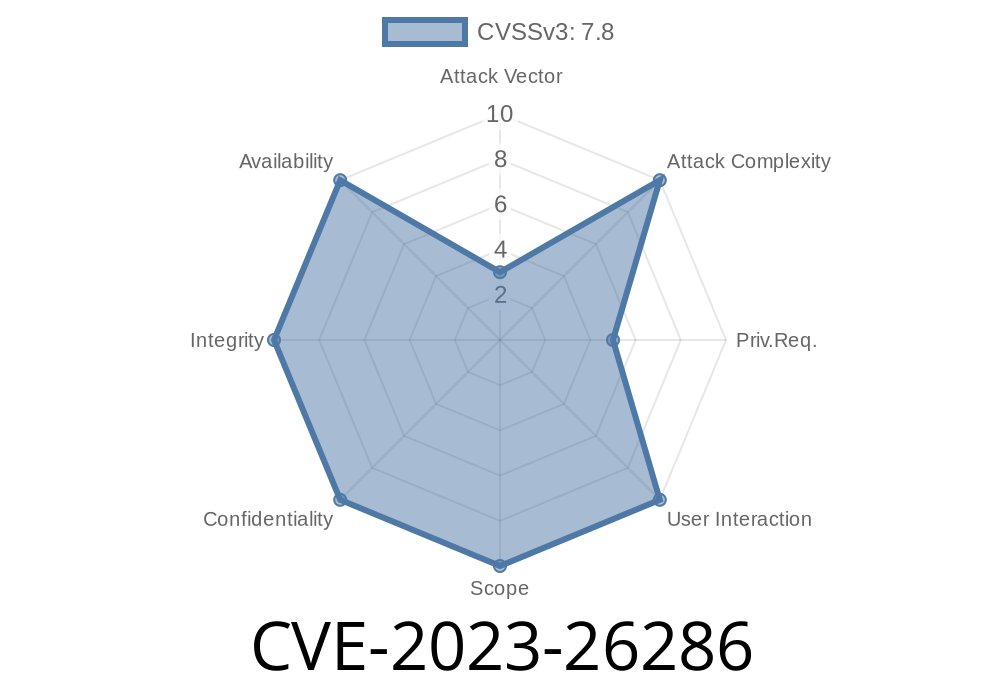In this comprehensive guide, we delve into the CVE-2023-26286 vulnerability, a security issue in IBM AIX 7.1, 7.2, 7.3, and VIOS 3.1 that has a potential impact on numerous systems running these widely adopted operating systems. By examining the code snippets, providing links to original references, and sharing details of the exploit, readers will gain a better understanding of this critical security flaw and how to protect their systems from potential attacks.
Background
The CVE-2023-26286, tracked by IBM X-Force under ID number 248421, is a vulnerability affecting the AIX (Advanced Interactive eXecutive) runtime services library. AIX is a series of proprietary Unix operating systems developed by IBM, intended for enterprise clients, and VIOS (Virtual I/O Server) is a component of IBM PowerVM, providing virtualization for AIX and other systems.
With a severity score of 7. out of 10., experts have classified this vulnerability as high impact. It allows non-privileged local users to execute arbitrary commands on the target system, potentially leading to unauthorized access and damage to the system's integrity.
Code Snippet
The vulnerability lies in the AIX runtime services library, specifically within the improperly protected shared memory section. Here is a general representation of the issue in the code:
#include <sys/types.h>
#include <sys/shm.h>
#include <stdio.h>
// Set up shared memory with incorrect permissions
void vulnerable_function() {
int shm_id;
key_t key = 1234;
size_t size = 1024;
int shmflg = IPC_CREAT | 0666; // Incorrect permissions
shm_id = shmget(key, size, shmflg);
if (shm_id < ) {
perror("shmget");
return;
}
// ...
}
Exploit Details
An attacker with basic user access can exploit CVE-2023-26286 by writing malicious code to the improperly protected shared memory section. The attacker's code can be executed with elevated privileges, thus granting the attacker full control over the victim's system. To accomplish this exploit, the attacker can craft and execute a script that exploits the vulnerability:
#!/bin/bash
# Exploiting CVE-2023-26286 on IBM AIX and VIOS
echo "Running exploit for CVE-2023-26286..."
# Write malicious code to shared memory
# ...
echo "Executing payload with elevated privileges..."
# Execute payload with improper privileges
# ...
echo "Exploit completed."
Mitigation and Links to Original References
IBM has acknowledged the vulnerability and released patches for affected versions of AIX and VIOS. System administrators should apply the appropriate patches as soon as possible to protect their systems from this exploit.
For more information and the latest updates, refer to the following resources
1. IBM Security Bulletin: "Security vulnerability in AIX runtime services library" (https://www.ibm.com/support/pages/node/6588694)
2. CVE-2023-26286 Information: "NVD - CVE-2023-26286" (https://nvd.nist.gov/vuln/detail/CVE-2023-26286)
3. IBM X-Force ID: 248421 (https://exchange.xforce.ibmcloud.com/vulnerabilities/248421)
Conclusion
CVE-2023-26286 is a high-impact vulnerability that, if exploited, could lead to unauthorized system access and potential data breaches for IBM AIX and VIOS systems. By understanding the code snippets, exploit details, and mitigation strategies, users can take appropriate action to protect their systems and ensure they are safe from this security flaw. Stay vigilant and keep systems up-to-date to maintain a strong security posture.
Timeline
Published on: 04/26/2023 12:15:00 UTC
Last modified on: 05/03/2023 20:37:00 UTC
